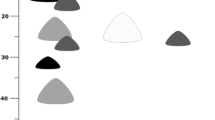Summary
Colonies of an Australian swarm founding polistine wasp,Ropalidia romandi, on the Atherton Tableland, Queensland, manage perennial nests by practicing seasonal colony activity. In “summer” nests, most cells were occupied by immatures of all developmental stages. The proportion of cells that did not contain immatures increased towards “winter”, when most nest cells did not contain immatures and half of these “winter” nests had rather large amounts of nectar deposited in empty cells. While the visits to tree flowers byR. romandi were not frequent in “summer”, nearly 60 % of insects collected on tree flowers in “winter” wereR. romandi. With such seasonal switching in the modes of colony reproductive activity and of nectar foraging behavior,R. romandi responds to its physical and biotic environment. In this way,R. romandi may be able to continue colonies throughout the year, with much reduced level of colony activity in “winter”, in areas with seasons that are unfavorable for reproductive activity of a colony.
Similar content being viewed by others
References
Carl. J., 1934.Ropalidia montana n. sp. et son nid. Un type nouveau d'architecture vespienne.Rev. Suisse Zool. 41:675–691.
Evans, H. E. and M. J. West-Eberhard, 1970.The wasps. University of Michigan Press, Ann Arbor. 265 pp.
Fitzsimon, J.D., 1992.Atherton weather records 1973–1991. CSIRO Tropical Forest Research Centre.
Gadagkar, R., 1991.Belonogaster, Mischocyttarus, Parapolybia, and independent-foundingRopalidia. In:The social biology of wasps (K. G. Ross and R. W. Matthews, Eds.), Cornell University Press, Ithaca, pp. 149–190.
Hunt, J. H., R. L. Jeanne, I. Baker and D. E. Grogan, 1987. Nutrient dynamics of a swarm-founding social wasp species,Polybia occicidentalis (Hymenoptera: Vespidae).Ethology 75:291–305.
Jeanne, R. L., 1972. Social biology of the Neotropical wasp,Mischocyttarus drewseni.Bull. Mus. Comp. Zool. Harvard Univ. 144:63–150.
Jeanne, R. L., 1980. Evolution of social behavior in the Vespidae.Annu. Rev. Entomol.25:371–396.
Jeanne, R. L., 1991. The swarm-founding Polistinae. In:The social biology of wasps (K. G. Ross and R. W. Matthews, Eds.), Cornell University Press, Ithaca, pp. 191–231.
Jeanne, R. L. and J. H. Hunt, 1992. Observations on the social waspRopalidia montana from peninsular India.J. Biosci. 17:1–14.
Kojima, J., 1989. Growth and survivorship of preemergence colonies ofRopalidia fasciata in relation to foundress group size in the subtropics (Hymenoptera: Vespidae).Ins. Soc. 36:197–218.
Kojima, J., 1993. Relative abundance of swarm-foundingRopalidia in the eusocial wasps (Hymenoptera: Vespidae) in tropical Australia.New Entomol. 42:4–7.
Kojima, J., 1994. Behavior during artificially induced swarm emigration in an Old World polistine wasp,Ropalidia romandi (Hymenoptera: Vespidae).J. Ethol. 12:1–8.
Moritz, R. F. A., 1994. Nourishment and sociality in honeybees. In:Nourishment and evolution in insect societies (J. H. Hunt and C. A. Nalepa, Eds.), Oxford and IBH Publishing Co. Pvt. Ltd. pp. 345–390.
National Astronomical Observatory (Ed.), 1994.Chronological scientific tables. Maruzen Co., Ltd.
Naumann, M. G., 1968. A revision of the genusBrachygastra (Hymenoptera: Vespidae).Univ. Kansas Sci. Bull. 47:929–1003.
Reeve, 1991.Polistes. In:The social biology of wasps (K. G. Ross and R. W. Matthews, Eds.), Cornell University Press, Ithaca, pp. 99–148.
Richards, O. W., 1978a. The Australian social wasps (Hymenoptera: Vespidae).Aust. J. Zool., Suppl Ser. 61:1–132.
Richards, O. W., 1978b.The social wasps of the Americas excluding the Vespinae. British Museum (Natural History). 580 pp + pls. 4.
Richards, O. W. and M. J. Richards, 1951. Observations on the social wasps of South America (Hymenoptera Vespidae).Trans. R. Ent. Soc. Lond. 102:1–170, 4 pls.
Schwarz, H. F., 1929. Honey wasps.Nat. Hist. 29:421–426.
Starr, C. K., 1991. The nest as the locus of social life. In:The social biology of wasps (K. G. Ross and R. W. Matthews, Eds.). Cornell University Press, Ithaca, pp. 520–539.
Strassmann, J. E., 1979. Honey caches help female paper wasps (Polistes annularis) survive Texas winters.Science 204:207–209.
Suzuki, H. and M. Murai, 1980. Ecological studies ofRopalidia fasciata in Okinawa Island. I. Distribution of single- and multiple-foundress colonies.Res. Popul. Ecol. 22:184–195.
West-Eberhard, M. J., 1969. The social biology of polistine wasps.Misc. Publ. Mus. Zool. Univ. Michigan 140:1–101.
Yamane, S., J. Kojima and S. Yamane, 1983. Queen/worker size dimorphism in an Oriental polistine wasp,Ropalidia montana Carl (Hymenoptera: Vespidae).Ins. Soc. 30:416–422.
Author information
Authors and Affiliations
Rights and permissions
About this article
Cite this article
Kojima, J. Colony cycle of an Australian swarm-founding paper wasp,Ropalidia romandi (Hymenoptera: Vespidae). Ins. Soc 43, 411–420 (1996). https://doi.org/10.1007/BF01258413
Received:
Revised:
Accepted:
Issue Date:
DOI: https://doi.org/10.1007/BF01258413




